MP Board Class 9th Maths Solutions Chapter 1 Number Systems Ex 1.3
Write the following in decimal form and say what kind of decimal expansion each has:
- \(\frac{36}{100}\)
- \(\frac{1}{11}\)
- 4\(\frac{1}{8}\)
- \(\frac{3}{13}\)
- \(\frac{2}{11}\)
- \(\frac{329}{400}\)
Solution:
1. \(\frac{36}{100}\)
\(\frac{36}{100}\) = 0.36
The decimal expansion is terminating.
2. \(\frac{1}{11}\)
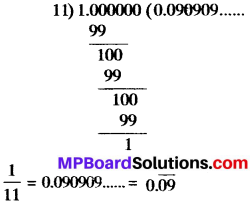
The decimal expansion is non-terminating repeating.
3. 4\(\frac{1}{8}\)
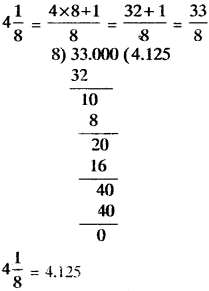
The decimal expansion is terminating.
4. \(\frac{3}{13}\)
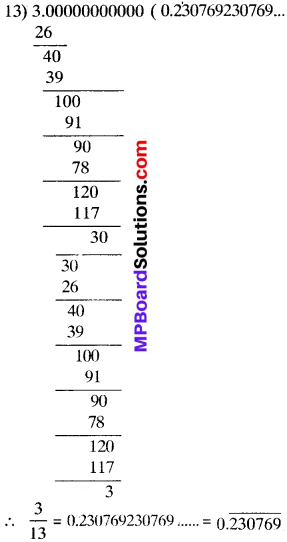
The decimal expansion is non-terminating repeating.
5. \(\frac{2}{11}\)
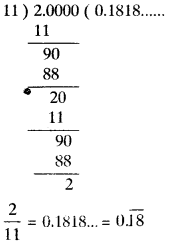
The decimal expansion is non-terminating repeating.
6. \(\frac{329}{400}\)
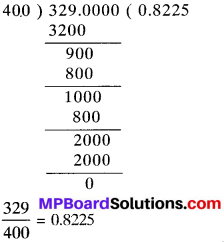
The decimal expansion is terminating.
Question 2.
You know that \(\frac{1}{7}\) = \(\overline { 0.142857 } \). Can vou predict what the decimal expansions of \(\frac{2}{7}\), \(\frac{3}{7}\), \(\frac{4}{7}\), \(\frac{5}{7}\), \(\frac{6}{7}\) are, without actually doing the long division? If so, how?
[Hint: Study the remainders while finding the value of \(\frac{1}{7}\) carefully.]
Solution:
\(\frac{1}{7}\) = \(\overline { 0.142857 } \)
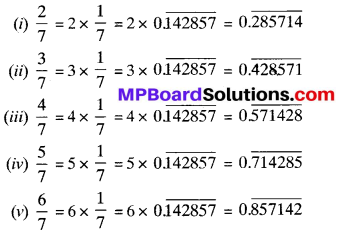
![]()
Question 3.
Expressthe following in the form \(\frac{p}{q}\), wherep and q are integers and q ≠ 0.
- \(0 . \overline{6}\)
- \(0 . \overline{oo1}\)
Solution:
1. \(0 . \overline{6}\)
Let x = \(0 . \overline{6}\) …(i)
10x = \(6 . \overline{6}\)
[Multiplying (i) by 10 on both sides] …(ii)
Subtracting (i) from (ii). we get
9x = 6
x = \(\frac{6}{9}\) = \(\frac{2}{3}\)
∴ \(6 . \overline{6}\) = \(\frac{2}{3}\)
2. \(0 . \overline{oo1}\)
1000x = \(1 . \overline{001}\)
[Multiplying (i) by 1000] …(ii)
Subtracting (i) from (ii), we get
999x = 1
x = \(\frac{1}{999}\)
∴ \(0 . \overline{001}\) = \(\frac{1}{999}\)
Question 4.
Express 0.99999….. in the form \(\frac{p}{q}\). Are you surprised by vour answer? With your teacher and classmates, discuss why the answer make sense.
Solution:
0.99999 = \(0 . \overline{9}\)
Let x = 0.9 …(i)
10x = \(9 . \overline{9}\)
[Multiplying (i) by 10] …(ii)
Subtracting (i) from (ii), we get
9x = 9
x = \(\frac{9}{9}\)
∴ \(9 . \overline{9}\) = 1
Question 5.
What can the maximum number of digits be in the repeating block of digits in the decimal expansion of \(\frac{1}{17}\)? Perform the division to check your answer.
Solution:
The maximum number of digits in the repeating block of digits in the decimal expansion \(\frac{1}{17}\) can be 16.
0. 05882352941176470588235294117647….

By Long Division, the number of digits in the repeating block of digits in the decimal expansion of = \(\frac{1}{17}\) = 16
∴ The answer is verified.
Question 6.
Look at several examples of rational numbers in the form \(\frac{p}{q}\) (q ≠ 0),where p and q are integers with no common factors other than 1 and having terminating decimal representation (expansions). Can you guess what property q must satisfy?
Solution:
Examples:
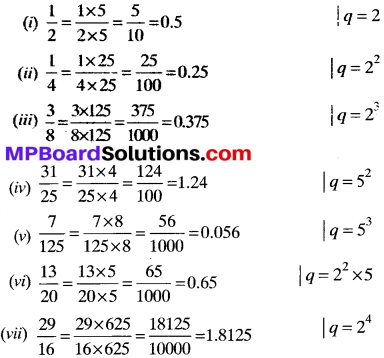
The property that q must satisfy is that the prime factorisation of q have only powers of 2 or powers of 5 or both.
Question 7.
Write three numbers whose decimal expansions are non – terminating non – recurring.
Solution:
0. 01001000100001……..,
0. 20200220002200002…….,
0. 003000300003
![]()
Question 8.
Find three different irrational numbers between the rational numbers \(\frac{5}{7}\) and \(\frac{9}{11}\).
Solution:
Irrational numbers between \(\frac{5}{7}\) and \(\frac{9}{11}\)
\(\frac{5}{7}\) = 0.71 and \(\frac{9}{11}\) = 0.81
Three irrational numbers between \(\frac{5}{7}\) and \(\frac{9}{11}\) are
0. 7201001000…
0. 7301001000…
0. 7401001000…
Question 9.
Classify the following numbers as rational or irrational:
- \(\sqrt{23}\)
- \(\sqrt{225}\)
- 0. 3796
- 7. 478478…
- 1. 101001000100001…
Solution:
- \(\sqrt{23}\) is an irrational number
- \(\sqrt{225}\) = 15, a rational number
- 0. 3796 is a rational number
- 7. 478478….. is an irrational number
- 1. 101001000100001… is an irrational number